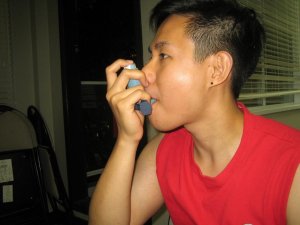
Exercised-induced asthma is asthma triggered by strenuous or extended physical exercise. Most people with chronic asthma are at greater risk for developing exercise-induced asthma. However, it is also possible for someone without chronic asthma to develop exercise-induced asthma. Asthma is a chronic inflammation of the bronchi of the lungs. Asthma attacks are usually triggered by external factors or specific situations.
During normal breathing, air enters through the nose where it is warmed and moistened by the nasal passages. However, during exercise, the tendency is to breathe through the mouth, thus inhaling colder and drier air. Because of the changes in temperature and humidity, the sensitive muscle bands around the airways contract causing the airways to narrow. After the attack is elicited, the airways begin to swell and discharge great amounts of mucus, which could partially or completely block the airways.
Exercise-Induced Asthma Symptoms
Symptoms of exercise-induced asthma typically begin within the first five to twenty minutes after beginning to exercise or after stopping from exercising. Narrowed and constricted airways show the following signs and symptoms:
- Coughing with asthma
- Chest tightness and pain
- Wheezing
- Shortness of breath when exercising
- Unusual fatigue
In children, symptoms may be less obvious. Symptoms include:
- Complaining of not being able to keep up with peers in sports and other games
- Avoiding participation in sports or games
Exercise-Induced Asthma First Aid Management
Exercise-induced asthma can be managed at home, especially in mild to moderate cases. If the person is having difficulties breathing, go to an emergency room or call for emergency medical services as soon as possible. For mild to moderate cases:
- If the person has an asthma plan, follow this action plan.
- Stay calm and do not panic. Do not leave the person alone at all times.
- Assist the person into sitting upright.
- Give the person quick-relief medications, also called rescue medications for short-term relief of symptoms. Some of the quick-relief medications include:
- Short-acting beta agonists
- Ipratropium (Atrovent)
- Some long-term control medications may be used but should be taken every day.
- Long-acting beta agonists
- Inhaled corticosteroids
- Leukotriene modifiers
- Theophylline
- Combination inhalers
Exercise-Induced Asthma Prevention
Just like all cases of asthma, exercise-induced asthma can be prevented or at the least, minimize risks for attacks. Some tips include:
- Take asthma inhalers 10-15 minutes before engaging in exercise.
- If one exercises in cold or dry air
- Breathe through the nose
- Wear a scarf or mask over the mouth.
- Avoid exercising in dirty or polluted air.
- Avoid exercising close to lawns or fields that have just been mowed.
- Before exercising, warm up. After exercising, cool down.
- If possible, avoid fast-paced activities as this triggers asthma such as, basketball, long-distance running, soccer and hockey, among others.
It is highly recommended for parents with children or anyone who lives with an asthmatic patient to join in first aid courses. The article above is for mere information but does not teach proper handling of these cases. To learn more about asthma attacks in children and management, join in St Mark James First Aid Training.
